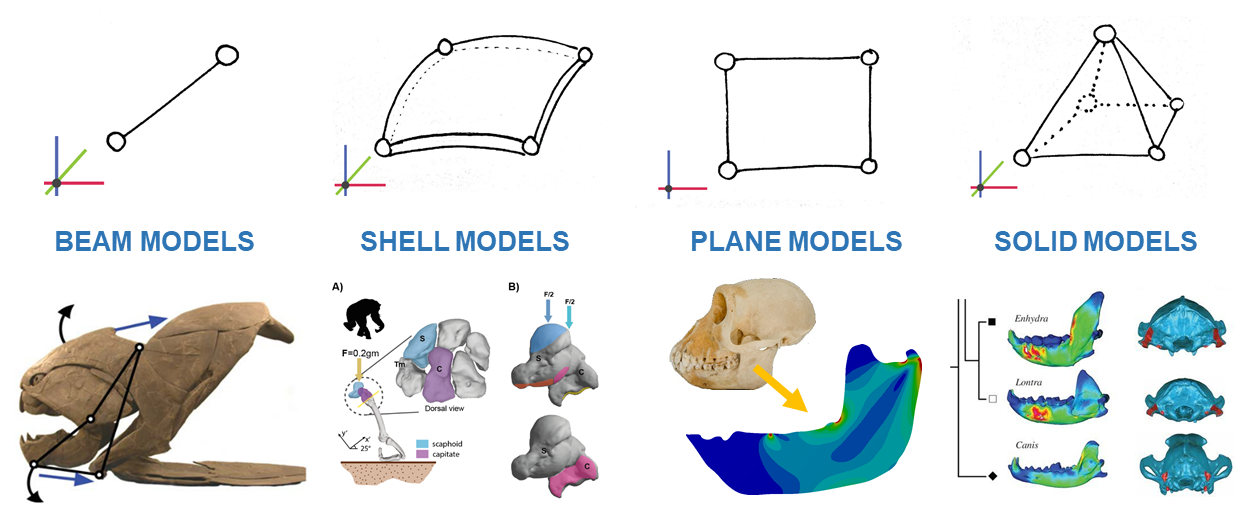|
During the months of the confinement due to the COVID-19 my colleagues from Transmitting Science asked me to record a short video to upload in the social networks. I decided to talk about the possibilities of Finite Element Analysis (FEA) in the field of vertebrates and when I mean possibilities, I mean different kind of elements, I mean different kind of geometries and, at the end of the street, different ways to create your FEA model. Because, of course, it is possible to use a tool from mechanical engineering to study the biomechanics of living and fossil vertebrates. It allows you for example to study locomotion or chewing and understand the evolution within their families.
But, what is Finite Element Analsys or FEA, which are the acronym of Finite Element Analysis? It is the matemathical way to solve problems of elasticity in complex geometries, so you can divide the geometry in tiny elements -but in a finite number- where the equations are easy to solve. Then, you can apply external forces in your model and understand how it deforms or how the inner forces are distributed inside the model. This method has been widely used in paleontology, antropology and functional morphology in general because now we can easily digitize the bony structures, so we can apply FEA in real geometries. But, we cannot omit that we are creating models. So, Anderson et al. wrote in 2012 this sentence that today is still true:
"By definition, and in practice, models are not literal representations of reality but provide simplifications or substitutes of the events, scenarios or behaviours that are being studied or predicted. All models make assumptions. Therefore, we are creating models that maybe are not enough close to the reality but they can be very useful for our purpose."
Following the idea of simplification that Anderson was underlying, there are different kind of elements that we can use when we are creating a FEA model. The use of some of this elements imply -of course- a simplification of the reality to a simple model. So, let me introduce you this different kind of elements and their features.
These are the options you have for adapting your geometries to your FEA model. But probably you are asking yourself two questions. The first one is: Which are the differences between shell elements and plane elements? Shell elements are not lying in a plane or, if yes, they allow forces that are not in the plane, like perpendicular forces. You can see this difference in the FEA models of the skull of several Temnospondyls (Fortuny et al. 2011) where the forces I applied are perpendicular to the flat surface of the skull.
And the second one: Probably you think that if you have a ct-scan and you create a FEA model with solid elements then you have a realistic model. I regret to inform you that this is the first step when creating FEA models and there is still a lot of decisions to make. And proabably, in most of them you will need to simplify your model because always remember that models are not literal representations of reality. References
Anderson, P.S.L.L., Westneat, M.W., 2007. Feeding mechanics and bite force modelling of the skull of Dunkleosteus terrelli, an ancient apex predator. Biol. Lett. 3, 77–80. https://doi.org/10.1098/rsbl.2006.0569
Fortuny, J., Marcé-Nogué, J., DE Esteban-Trivigno, S., Gil, L., Galobart, Á., 2011. Temnospondyli bite club: ecomorphological patterns of the most diverse group of early tetrapods. J. Evol. Biol. 24, 2040–54. https://doi.org/10.1111/j.1420-9101.2011.02338.x Marcé-Nogué, J., Püschel, T.A., Kaiser, T.M., 2017. A biomechanical approach to understand the ecomorphological relationship between primate mandibles and diet. Sci. Rep. 7, 8364. https://doi.org/10.1038/s41598-017-08161-0 Püschel, T.A., Marcé-Nogué, J., Chamberlain, A.T., Yoxall, A., Sellers, W.I., 2020. The biomechanical importance of the scaphoid-centrale fusion during simulated knuckle-walking and its implications for human locomotor evolution. Sci. Rep. 10, 3526. https://doi.org/10.1038/s41598-020-60590-6 Tseng, Z.J., Grohé, C., Flynn, J.J., 2016. A unique feeding strategy of the extinct marine mammal Kolponomos : convergence on sabretooths and sea otters. Proc. R. Soc. B Biol. Sci. 283, 20160044. https://doi.org/10.1098/rspb.2016.0044
1 Comment
Thanks for helping me understand that finite element analysis consulting will be able to solve problems regarding elasticity in complex geometries which can make it easier to solve. It must be helpful to work with experts in this field to understand this more when you need these procedures for your business. The technology industry is really fascinating to me because of the many improvements, advancements, and benefits they can provide for people and their daily lives as well.
Reply
Leave a Reply. |

